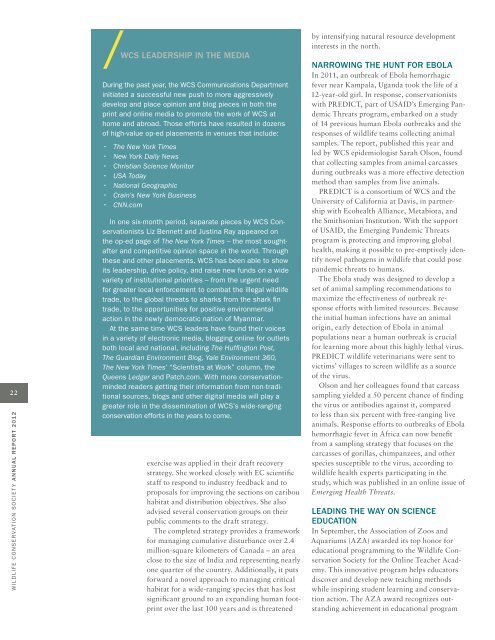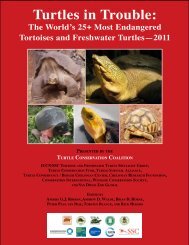WCS Annual Report 2012 - Wildlife Conservation Society
WCS Annual Report 2012 - Wildlife Conservation Society
WCS Annual Report 2012 - Wildlife Conservation Society
Create successful ePaper yourself
Turn your PDF publications into a flip-book with our unique Google optimized e-Paper software.
22<br />
wildlife conservation society <strong>Annual</strong> <strong>Report</strong> <strong>2012</strong><br />
/ <strong>WCS</strong> Leadership in the Media<br />
During the past year, the <strong>WCS</strong> Communications Department<br />
initiated a successful new push to more aggressively<br />
develop and place opinion and blog pieces in both the<br />
print and online media to promote the work of <strong>WCS</strong> at<br />
home and abroad. Those efforts have resulted in dozens<br />
of high-value op-ed placements in venues that include:<br />
• The New York Times<br />
• New York Daily News<br />
• Christian Science Monitor<br />
• USA Today<br />
• National Geographic<br />
• Crain’s New York Business<br />
• CNN.com<br />
In one six-month period, separate pieces by <strong>WCS</strong> <strong>Conservation</strong>ists<br />
Liz Bennett and Justina Ray appeared on<br />
the op-ed page of The New York Times – the most soughtafter<br />
and competitive opinion space in the world. Through<br />
these and other placements, <strong>WCS</strong> has been able to show<br />
its leadership, drive policy, and raise new funds on a wide<br />
variety of institutional priorities – from the urgent need<br />
for greater local enforcement to combat the illegal wildlife<br />
trade, to the global threats to sharks from the shark fin<br />
trade, to the opportunities for positive environmental<br />
action in the newly democratic nation of Myanmar.<br />
At the same time <strong>WCS</strong> leaders have found their voices<br />
in a variety of electronic media, blogging online for outlets<br />
both local and national, including The Huffington Post,<br />
The Guardian Environment Blog, Yale Environment 360,<br />
The New York Times’ “Scientists at Work” column, the<br />
Queens Ledger and Patch.com. With more conservationminded<br />
readers getting their information from non-traditional<br />
sources, blogs and other digital media will play a<br />
greater role in the dissemination of <strong>WCS</strong>’s wide-ranging<br />
conservation efforts in the years to come.<br />
exercise was applied in their draft recovery<br />
strategy. She worked closely with EC scientific<br />
staff to respond to industry feedback and to<br />
proposals for improving the sections on caribou<br />
habitat and distribution objectives. She also<br />
advised several conservation groups on their<br />
public comments to the draft strategy.<br />
The completed strategy provides a framework<br />
for managing cumulative disturbance over 2.4<br />
million-square kilometers of Canada – an area<br />
close to the size of India and representing nearly<br />
one quarter of the country. Additionally, it puts<br />
forward a novel approach to managing critical<br />
habitat for a wide-ranging species that has lost<br />
significant ground to an expanding human footprint<br />
over the last 100 years and is threatened<br />
by intensifying natural resource development<br />
interests in the north.<br />
Narrowing the Hunt for Ebola<br />
In 2011, an outbreak of Ebola hemorrhagic<br />
fever near Kampala, Uganda took the life of a<br />
12-year-old girl. In response, conservationists<br />
with PREDICT, part of USAID’s Emerging Pandemic<br />
Threats program, embarked on a study<br />
of 14 previous human Ebola outbreaks and the<br />
responses of wildlife teams collecting animal<br />
samples. The report, published this year and<br />
led by <strong>WCS</strong> epidemiologist Sarah Olson, found<br />
that collecting samples from animal carcasses<br />
during outbreaks was a more effective detection<br />
method than samples from live animals.<br />
PREDICT is a consortium of <strong>WCS</strong> and the<br />
University of California at Davis, in partnership<br />
with Ecohealth Alliance, Metabiota, and<br />
the Smithsonian Institution. With the support<br />
of USAID, the Emerging Pandemic Threats<br />
program is protecting and improving global<br />
health, making it possible to pre-emptively identify<br />
novel pathogens in wildlife that could pose<br />
pandemic threats to humans.<br />
The Ebola study was designed to develop a<br />
set of animal sampling recommendations to<br />
maximize the effectiveness of outbreak response<br />
efforts with limited resources. Because<br />
the initial human infections have an animal<br />
origin, early detection of Ebola in animal<br />
populations near a human outbreak is crucial<br />
for learning more about this highly lethal virus.<br />
PREDICT wildlife veterinarians were sent to<br />
victims’ villages to screen wildlife as a source<br />
of the virus.<br />
Olson and her colleagues found that carcass<br />
sampling yielded a 50 percent chance of finding<br />
the virus or antibodies against it, compared<br />
to less than six percent with free-ranging live<br />
animals. Response efforts to outbreaks of Ebola<br />
hemorrhagic fever in Africa can now benefit<br />
from a sampling strategy that focuses on the<br />
carcasses of gorillas, chimpanzees, and other<br />
species susceptible to the virus, according to<br />
wildlife health experts participating in the<br />
study, which was published in an online issue of<br />
Emerging Health Threats.<br />
Leading the Way on Science<br />
Education<br />
In September, the Association of Zoos and<br />
Aquariums (AZA) awarded its top honor for<br />
educational programming to the <strong>Wildlife</strong> <strong>Conservation</strong><br />
<strong>Society</strong> for the Online Teacher Academy.<br />
This innovative program helps educators<br />
discover and develop new teaching methods<br />
while inspiring student learning and conservation<br />
action. The AZA award recognizes outstanding<br />
achievement in educational program







![RaLand / SeaScape [PDF] - Wildlife Conservation Society](https://img.yumpu.com/49974326/1/190x245/raland-seascape-pdf-wildlife-conservation-society.jpg?quality=85)









